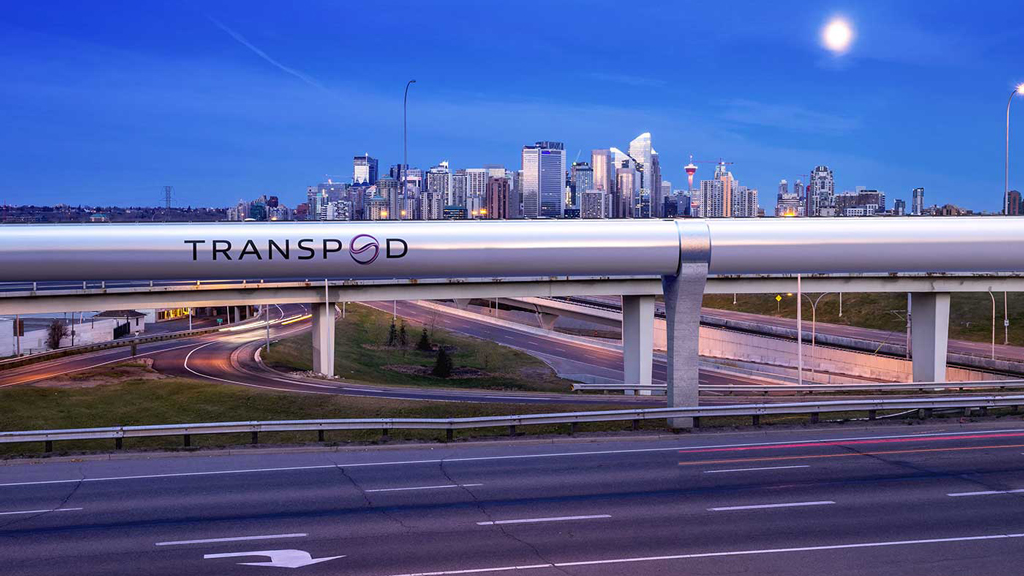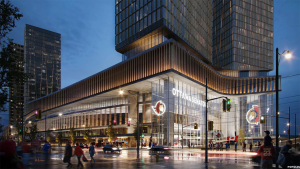Need to go from Edmonton to Calgary? With emerging hyperloop technology being developed by Canadian-based TransPod, the journey could soon take roughly an hour without having to set foot on an airplane or burn fossil fuels.
According to a feasibility study recently released by TransPod, the system will carry passengers and cargo faster than 600 km/h, far faster than a high-speed train. A trip between the two cities would cost around $90. The electric system is built on a proprietary design that leverages aerospace engineering. The company is developing this technology with high safety standards in collaboration with the European Union and United States transportation departments. The TransPod vehicle’s top speed is similar to a jet, but it travels at ground level in a protected guideway.
Sebastien Gendron, co-founder and CEO of TransPod Inc., believes the system could generate massive economic benefits for Alberta’s struggling economy by creating a new high-tech industry ripe for export. He explained the basic concept for a system like TransPod’s has been around for more than a century.
“If you really want to go beyond 200 km/h at ground level you need to get rid of aerodynamic friction,” said Gendron. “That’s when people started to think about removing most of the air in a tube.”
This is achieved by creating a low-pressure environment around a sealed track. The vehicles are propelled by linear induction engines, which are powered by fully electric energy. TransPod’s JetGlide technology controls a magnetic levitation system to keep the vehicle off the bottom of the tube guideway, creating a smooth ride, and reducing energy consumption due to an absence of mechanical friction between the vehicle and that limits traditional trains.
While TransPod is not the first to envision a hyperloop system, they are attempting to revolutionize the idea by solving one of its biggest problems: cost.
The main challenge faced by previous vacuum tube transportation systems is the staggering cost of maglev technology which uses the repulsion force of superconducting magnets on the track to levitate the train cars. Instead, Gendron and his team will use the attraction force generated by magnetic engines on the vehicle to achieve this.
“Our idea is the concentrate all the technology on the vehicle and leave the infrastructure as simple as possible,” said Gendron.
The feasibility report estimates the entire system could be built for $22.4 billion. And to make it turn a profit, Gendron and his team found another way to stretch dollars and make the project more appealing to investors.
“We realized you must not only look at the occupancy level of the train but instead the utilization of infrastructure,” said Gendron. “If you can’t fill it, you can’t make money.”
That means transporting more than people. Gendron said there is massive opportunity for DHL, FedEx, Amazon and others to reduce the carbon footprint of their trucks and planes by shipping on the TransPod system. The team’s research shows that initially 60 per cent of the system’s traffic would be freight rather than people.
But before anything is put on TransPod’s aerospace-inspired, autonomous vehicles, the team is planning to build a test track to Edmonton’s airport. And once the 20 kilometre system receives all authorizations by officials it will be connected and used by the public.
Gendron said his team expects to secure funding for the test track sometime this year and is already in discussions to fund the full system. The test track would take two years to build and could have passengers by 2027.
Currently Gendron and his team are working on building 1/4th scale vehicles and track portions to demonstrate the technology.
“Our objective is to contribute to the province’s diversification,” said Gendron. “We want to contribute to the transformation of the existing economy into something greener.”
The team also wants to ensure Indigenous groups are included and have reached out to begin this process.
“We want this project to be as inclusive as possible and we are starting to approach First Nations to see how they can benefit,” said Gendron.
He team is also closely watching the European Union’s efforts to regulate hyperloop systems which would give Canada a regulatory framework potentially by 2025.
“We hope to soon be bringing all the pieces of the puzzle together,” said Gendron.
Follow the author on Twitter @RussellReports.











Anther pink pipe dream, travelled with Transrapid Maglev. At least you can look outside the train, rides smooth like silk. Firstly build a test facility to try this thing out.
Computer simulations just won‘t cut it.
Hyperloop is a joke and a scam to soak up investment and subsidies which will disappear into someone’s pockets. There isn’t a single working prototype in the world, and this clown thinks he’s going to build it between two cities.. while ignoring half the value of high-speed rail- connectivity and commuter access for all the towns in between.
100% hype. But every idiot and his dog believes it because Elon Musk promoted it on one of his toked-up ramblings. His ‘hyperloop demo’ in Las Vegas is a concrete tunnel less than 2 miles long with his electric cars driving in circles..
Haha. Been through this idea many times.
It’s a tube dream.
Bad idea…..too much tech…too much money….too dangerous….just give us 125 kms/hr lrt on old highway 2A, connect a dozen cities….students, businessmen and traveller’s will enjoy it. Great for tourism. Second legs connect jasper edmobyon and Banff Calgary…….third jasper to Banff creating a loop……millions of tourists will come…..go on loop…stay have fun …move to next stage…..sell monthly passes …students get from universities….etc
Maintaining a vacuum or near-vacuum along that length would also be hugely difficult—with catastrophic consequences for failure. Cost isn’t the only problem with the Hyperloop concept.
You realize how insanely stupid this would be any kinds of warping movement with the ground bucking or buckling of the tube would result in catastrophic and violent failure? Not only that but it’s going to have to have air compressors every 10 to 15 m just to keep it down to a vacuum… This isn’t possible this isn’t even feasible in the next 200 years.
Imagine chasing down air leaks on every single segment that’s been welded every single compressor seal every single rail segment that’s bolted into it would have to be sealed every bolt would have to have high pressure seals beyond what NASA makes.
Not only that how much more it would cost than just putting a maglev train in between the two and that would be able to cart a few hundred people each day, for only like 15 to $20 instead and you could pull power it with wind and solar… Instead of the insanely energy intensive nature of a vacuum tube.
First lie is no carbon being used. Whats wrong with carbon. We are made of carbon.
How to make this inclusive with our natives?
Lets make it beneficial and inclusive for ME
Does anyone think this will ever get off the ground…..????…and even if it does how long will it survive???
Amusing. Hyperloop is a pretty good joke. Hope people don’t put too much money into this scam. Especially with the EllisDon partnership announced today to push forward conventional High Speed Rail. Let’s get that done, a tired and true technology, at least we know it’s possible.
This loop project should be extended by Washington’s areas.
Nay sayers say nay.
We need a transportation system that goes from town to town
Anyone else imagining if the power goes out and the train stops, everyone suffocating to death, trapped inside? Kind of scary thought….
This it a pipe dream that’s been so thoroughly debunked as completely impractical and impossible to implement. A proper scientist has already pointed the flaws out for the entire system.
$22 Bn and year 2027? Even if they can buy and use the XL pipeline tube from Jason , the time and cost will be a sweet dream for Alberta
nice and fast but at 35 and 40 bellow wheather and 3 feet of snow ?
Most interesting and intreging concept.
To build a 1/4 scale model to prove the concept to investors must still be very expensive. Would a 1/10 scale be more feasible. ?
Really? In Alberta? Can we just make the roads better, we have nothing to do in edmonton or calgary going at that speed and reaching there in 30 mins.
Just fix our roads!
Hyperloop is a scam…
Very unique idea and would benefit a lot of people. However, I think the roadway from Edmonton to Calgary shouldn’t have a speed limit, similar to how other countries have no speed limit on certain highways.